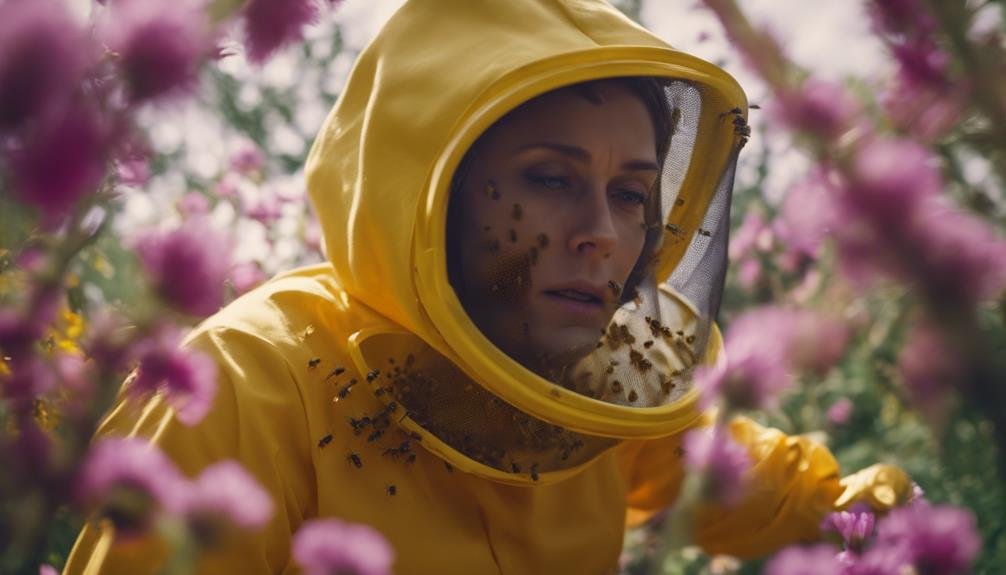Creating a Buzz: How to Start Your Own Beekeeping Business
If you've ever observed a beehive on a warm summer day, you might have marveled at the intricate dance of the bees as they go about their work. Starting your own beekeeping business can be equally fascinating and rewarding.
From the gentle hum of bees in your backyard to the sweet rewards of harvesting your own honey, embarking on this journey offers more than just a business opportunity. The world of beekeeping is multifaceted, blending science, nature, and entrepreneurship into a unique venture that promises not only sweet returns but also a deeper connection to the environment and the intricate workings of a bee colony.
Key Takeaways
- Develop a detailed business plan to navigate challenges and opportunities effectively.
- Maintain bee health through regular inspections and hygiene practices.
- Choose a suitable location and set up hives strategically for optimal beekeeping conditions.
- Utilize technology for efficient inventory tracking, marketing, and business growth.
Beekeeping Business Basics
When starting your beekeeping business, ensure you have a solid understanding of the basics to set yourself up for success.
Beekeeping business planning is the cornerstone of your venture. Begin by outlining your goals, budget, and marketing strategies. Conduct a thorough profitability analysis to determine the potential income and expenses associated with beekeeping. Understanding the financial aspects will help you make informed decisions and set realistic expectations for your business.
In the realm of beekeeping business planning, consider factors such as the initial investment required for equipment, hive maintenance costs, and possible revenue streams like honey sales or pollination services. A detailed business plan will serve as your roadmap, guiding you through challenges and opportunities that may arise.
Profitability analysis is crucial for assessing the feasibility of your beekeeping business. Calculate the costs of acquiring bees, protective gear, and extracting equipment against the expected returns from honey production. This meticulous evaluation will help you gauge the sustainability and growth potential of your beekeeping venture.
Essential Equipment and Supplies
To establish a successful beekeeping business, equipping yourself with the essential tools and supplies is paramount for efficiently managing your hives and ensuring optimal honey production. Here are four crucial aspects to consider when it comes to equipment and supplies:
- Equipment Maintenance: Regularly maintaining your beekeeping equipment is vital for the health of your bees and the quality of your honey. Keep your tools clean, inspect hives for damage, and repair or replace any worn-out components promptly.
- Supplier Relationships: Building strong relationships with reliable suppliers is key to ensuring a steady and timely flow of necessary equipment and supplies. Establishing good communication and understanding with your suppliers can help you secure better deals and access to high-quality products.
- Cost Management: Keeping track of your expenses and finding cost-effective solutions for your equipment needs is essential for a profitable beekeeping business. Look for bulk discounts, compare prices from different suppliers, and consider investing in durable equipment that offers long-term value.
- Inventory Tracking: Maintaining an organized inventory system will help you keep track of your supplies, prevent shortages, and ensure you have everything you need when managing your hives. Consider using digital tools or spreadsheets to monitor your inventory levels efficiently.
Choosing the Right Location
Choosing the right location for your beekeeping operation requires careful consideration of various factors to ensure the success and productivity of your hives. When selecting a site, assess the land suitability for beekeeping activities. Look for areas with access to diverse flora that can provide a variety of nectar and pollen sources for your bees. Additionally, check the zoning regulations in your area to ensure that beekeeping is permitted and that there are no restrictions that could hinder your operation.
Consider the environmental impact of your beekeeping venture. Opt for locations that promote sustainability and biodiversity. Avoid areas with high levels of chemical pesticide usage, as these can harm your bees and the quality of your honey. A sustainable location won't only benefit your bees but also contribute positively to the local ecosystem.
Ultimately, choosing the right location is crucial for the long-term success of your beekeeping business. By prioritizing land suitability, zoning regulations, and sustainability, you can create a thriving environment for your bees to flourish and produce high-quality honey.
Setting Up Your Beehives
To establish a thriving beekeeping venture, meticulously setting up your beehives is a fundamental step that will lay the foundation for the health and productivity of your bee colonies. Here's what you need to consider:
- Location: Choose a site with access to sunlight, near water sources, and protected from strong winds.
- Orientation: Ensure the entrance faces east or south to receive the morning sun, helping bees start their day early.
- Equipment: Have all necessary tools ready, including protective gear, smoker, hive tool, and bee brush.
- Initial Inspection: Before introducing bees, check the hive for any damage, ensure frames are spaced correctly, and have a feeder ready with sugar syrup to aid bees in establishing their new home.
Proper hive maintenance and regular inspection are crucial for the well-being of your bees. Understanding the role of the queen bee in brood care will also be essential to the success of your beekeeping business.
Understanding Bee Behavior
You must grasp the intricate ways bees communicate within the hive, from the waggle dance to pheromone signals. Understanding these behaviors is key to managing your bee colonies effectively.
Observing foraging patterns will also provide insight into your bees' health and productivity.
Hive Communication
Understanding bee behavior is crucial for successful hive communication in your beekeeping business. Bees have fascinating ways of interacting and conveying information within the hive. Here are some key points to help you grasp the intricacies of hive communication:
- Waggle Dance: Bees perform the famous waggle dance to communicate the location of food sources to other members of the colony.
- Queen Pheromones: The queen bee releases pheromones that regulate the behavior and interaction of the hive, ensuring harmony.
- Worker Signals: Workers use various signals like vibrations and odor cues to convey danger, resource availability, or even the need to swarm.
- Temperature Regulation: Bees also communicate through maintaining specific temperatures within the hive for brood development and overall colony health.
Understanding these communication methods will help you manage your beekeeping business effectively.
Foraging Patterns
Bee foraging patterns play a crucial role in understanding the intricate behavior of bees within a hive. Bees exhibit remarkable efficiency in collecting nectar and pollen from flowers, contributing to the pollination benefits that are crucial for sustaining ecosystems. By observing their foraging patterns, beekeepers can gain valuable insights into the health of their colonies and the availability of resources in the surrounding environment. Understanding these patterns not only aids in maximizing honey production but also promotes sustainability by supporting the natural processes of pollination. Moreover, recognizing and documenting these behaviors can create opportunities for beekeepers to engage with the wider beekeeper community, fostering networking opportunities and knowledge sharing that can benefit both novice and experienced individuals in the field.
| Pollination Benefits | Sustainability | Beekeeper Community |
|---|---|---|
| Crucial for ecosystems | Promotes environmental balance | Networking opportunities |
Bee Health and Disease Management
Ensuring the well-being of your bees through proper health management practices is crucial for a thriving beekeeping business. As a passionate beekeeper, you must be knowledgeable about disease prevention, treatment, and colony collapse prevention to maintain a healthy bee population. Here are some essential tips to help you manage bee health effectively:
- Regular Inspections: Conduct frequent hive inspections to check for any signs of disease or stress among your bees.
- Hygienic Practices: Keep your beekeeping equipment clean and practice good hygiene to prevent the spread of diseases within the colony.
- Varroa Mite Control: Implement a varroa mite management plan to protect your bees from this common parasite that can weaken colonies.
- Healthy Nutrition: Provide your bees with a diverse and nutritious diet by ensuring they've access to a variety of flowers and plants for foraging.
Harvesting Honey and Other Products
Maintaining a healthy bee population through effective disease management sets the foundation for a successful beekeeping business. Now, let's explore the intricate process of harvesting honey and other valuable bee products.
When it comes to harvesting honey, the process involves careful steps to ensure a high-quality product. Honey extraction is a pivotal task, requiring specialized equipment like extractors to spin the honey out of the comb gently. Once the honey is extracted, proper filtration and storage are crucial to maintain its purity and flavor. Beeswax processing is another essential aspect, where the beeswax is collected, melted, and purified for various uses like making candles or skincare products.
In addition to honey and beeswax, beekeepers can collect other valuable products from their hives. Pollen collection is done by installing traps at the hive entrance, gathering this nutrient-rich substance for consumption. Propolis harvesting involves scraping off the sticky resin bees use to seal gaps in the hive, known for its medicinal properties. Mastering the art of harvesting these products will not only benefit your bees but also elevate your beekeeping business to new heights.
| Bee Product | Harvesting Method | Usage |
|---|---|---|
| Honey | Extraction | Culinary, Medicinal |
| Beeswax | Processing | Candles, Skincare |
| Pollen | Collection | Nutritional Supplements |
| Propolis | Harvesting | Medicinal Purposes |
Marketing Your Bee Products
To effectively market your bee products, understanding your target audience's preferences and needs is essential for maximizing sales and brand recognition. Here are four key strategies to help you effectively market your bee products:
- Online Presence:
Establish a strong online presence through a professional website and active engagement on social media platforms like Instagram and Facebook. Share captivating photos and stories about your bee products to attract potential customers.
- Attend Farmers Markets and Local Events:
Participate in local farmers markets and community events to showcase your bee products directly to consumers. Offer samples, engage in conversations, and provide information about the benefits of your products.
- Create Buzz Through Word-of-Mouth:
Encourage satisfied customers to spread the word about your bee products. Offer referral discounts or incentives to loyal customers who recommend your products to their friends and family.
- Collaborate with Influencers:
Partner with local influencers or bloggers who align with your brand values to promote your bee products to a wider audience. Their endorsement can help increase visibility and credibility for your products.
Regulatory and Legal Considerations
Understanding the regulatory and legal considerations surrounding your beekeeping business is crucial for ensuring compliance and protecting your operation. When starting your beekeeping business, you must be aware of permit requirements and zoning laws in your area. Different regions may have specific regulations regarding the keeping of bees, so it's essential to research and adhere to these guidelines. Additionally, obtaining liability insurance is key to safeguarding your business from potential risks. Having solid contract agreements with suppliers or buyers can also protect your interests and prevent misunderstandings. By staying informed and proactive in addressing regulatory and legal aspects, you can establish a strong foundation for your beekeeping venture.
| Regulatory and Legal Considerations | |
|---|---|
| Permit Requirements | Zoning Laws |
| Ensure compliance with local laws | Research regulations in your area |
| Liability Insurance | Contract Agreements |
| Protect your business from risks | Establish clear agreements |
Growing and Scaling Your Business
As you expand your beekeeping business and aim for growth, strategizing on how to scale effectively becomes paramount to maximize your success in the industry.
To ensure the successful growth and scaling of your beekeeping business, consider the following:
- Diversify Your Products: Explore new honey varieties, beeswax products, or bee-related merchandise to attract a broader customer base and increase revenue streams.
- Invest in Marketing: Utilize social media platforms, attend local fairs, and collaborate with stores to promote your products and services, attracting more customers and boosting revenue growth.
- Expand Your Beehives: Increasing the number of beehives won't only enhance honey production but also allow for scalability, enabling you to meet growing demands and expand your business reach.
- Automate Processes: Implementing technology like hive monitors, automated extractors, and inventory management systems can streamline operations, increase efficiency, and free up time for focusing on business expansion and revenue growth.
Conclusion
Now that you have all the buzz about starting your own beekeeping business, remember: 'The early bird catches the worm.'
With the right equipment, location, and knowledge of bee behavior, you're ready to dive into the sweet world of honey production.
From harvesting to marketing, there's a world of opportunities waiting for you in the bee business.
So go out there, follow your passion, and watch your beekeeping dreams take flight!







